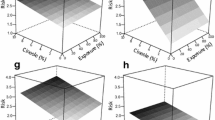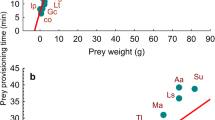Summary
In earlier work (Lima et al. 1985; Lima 1985), we found that gray squirrels (Sciurus carolinensis) and black-capped chickadees (Parus atricapillus) when exploiting a patch of food in the open often carried individual food items to protective cover for consumption. Their tendency to carry (i) decreased as distance of the patch from cover increased, and (ii) increased as size of the available food items increased. A simple model indicated that this behavior was consistent with a trade-off between efficient foraging and predation risk. Maximal feeding efficiency was achieved by always eating at the patch, whereas minimal time exposure to predators was achieved by carrying all items to cover for consumption. Because predation-riskrelated trade-offs are likely to be of importance in the determination of feeding behavior, we surveyed the behavior of 10 bird species feeding under similar conditions to assess both the generality of the above results and the adequacy of some simple assumptions concerning the assessment and perception of predation risk.
We observed considerable interspecific variability in behavior. Of the 10 species studied, 4 behaved in a manner similar to the squirrels and chickadees. Five other species showed an increased tendency to carry with larger items but no clear tendency to decrease carrying from longer distances. The one remaining species exhibited neither behavioral trend.
The model that predicted squirrel and chickadee behavior failed to account for all observed behavior. The behavior of all species, however, was influenced by predation risk, and the discrepancy between theory and observation most likely reflects shortcomings of the model. These discrepancies indicate that other factors, in addition to exposure time, may be of significance in the perception of predation risk by several (or all) of the species studied. Of particular importance may be a distance-dependent probability of escaping attack. Other results indicate that predation risk may influence handling times via aspects of the digestive process.
Similar content being viewed by others
References
Barnard CJ (1980) Flock feeding and time budgets in the house sparrow (Passer domesticus L.). Anim Behav 28:295–309
Brody S (1945) Bioenergetics and growth. Reinhold Publ Corp NY
Calow P (1977) Ecology, evolution and energetics-study in metabolism. Biol Revs 52:385–409
Caraco T, Martindale S, Pulliam HR (1980) Avian time budgets and distance to cover. Auk 97:872–875
Dill LM, Fraser AGH (1985) Risk of predation and the feeding behavior of juvenile coho salmon (Oncorhynchus kisutch). Behav Ecol Sociobiol 16:65–71
Fraser DF, Cerri RD (1982) Experimental evaluation of predatorprey relationships in a patchy environment: consequences for habitat use patterns in minnows. Ecology 63:307–313
Fretwell SD (1972) Populations in a seasonal environment. Princeton University Press, New Jersey
Fritz JC (1937) The effect of feeding grit on digestibility in the domestic fowl. Poultry Sci 16:75–79
Gilliam, JF (1982) Habitat use and competitive bottlenecks in sizestructured fish populations. Ph D thesis, Michigan State University
Grubb TC, Greenwald L (1982) Sparrows and a brushpile: foraging responses to different combinations of predation risk and energy cost. Anim Behav 30:637–640
Kendeigh SC (1944) Effect of air temperature on the rate of energy metabolism in the English Sparrow. J Exp Zool 96:1–16
Kendeigh SC (1949) Effect of temperature and season on energy resources of the English Sparrow. Auk 66:113–127
Kotler BP (1984a) Risk of predation and the structure of desert rodent communities. Ecology 65:689–701
Kotler BP (1984b) Harvesting rates and predatory risk in desert rodents: a comparison of two communities on different continents. J Mamm 65:91–96
Krebs JR (1980) Optimal foraging, predation risk, and territory defence. Ardea 68:83–90
Lima SL (1985) Maximizing feeding efficiency and minimizing time exposed to predators: a trade-off in the black-capped chickadee. Oecologia (Berlin) 66:60–67
Lima SL (1986) Predation risk and unpredictable feeding conditions: determinants of body mass in birds. Ecology 67:377–385
Lima SL (1987) Distance to cover, visual obstructions and vigilance in house sparrows. Behaviour (in press)
Lima SL, Valone TJ (1986) Influence of predation risk on diet selection: a simple example in the grey squirrel. Anim Behav 34:536–544
Lima SL, Valone TJ, Caraco T (1985) Foraging-efficiency-predation-risk trade-off in the grey squirrel. Anim Behav 33:155–165
Lockard RB, Owings DH (1974) Moon-related surface activity of bannertail (Dipodomys spectabilis) and fresno (D nitratoides) kangaroo rats. Anim Behav 22:262–273
McNamara JM, Houston AI (1986) The common currency for behavioral decisions. Am Nat 127:358–378
Milinski M, Heller R (1978) Influence of a predator on the optimal foraging behaviour of sticklebacks (Gasterosteus aculeatus L). Nature 275:642–644
Mittelbach GG (1981) Foraging efficiency and body size: a study of optimal diet and habitat use by bluegills. Ecology 62:1370–1386
Mittelbach GG (1984) Predation and resource partitioning in two sunfishes (Centrarchidae). Ecology 65:499–513
Murie A (1951) Coyote food habits on a southwestern cattle range. J Mamm 32:291–295
Phelan FJS, Robertson RJ (1978) Predatory responses of a raptor guild to changes in prey density. Can J Zool 56:2565–2572
Power ME (1984) Depth distributions of armored catfish: predator-induced resource avoidance. Ecology 65:523–528
Pulliam HR, Mills GS (1977) The use of space by wintering sparrows. Ecology 58:1393–1399
Schneider KJ (1984) Dominance, predation, and optimal foraging in white-throated sparrow flocks. Ecology 65:1820–1827
Sih A (1982) Foraging strategies and the avoidance of predation by an aquatic insect, Notonecta hoffmanni. Ecology 63:786–796
Werner EE, Gilliam JF, Hall DJ, Mittelbach GG (1983) An experimental test of the effects of predation risk on habitat use in fish. Ecology 64:1540–1548
Ydenberg RC, Dill LM (1986) The economics of fleeing from predators. Adv Study Behav 16:229–249
Zimmerman JL (1965) Digestive efficiency and premigratory obesity in the Dickcissel. Auk 82:278–279
Author information
Authors and Affiliations
Rights and permissions
About this article
Cite this article
Valone, T.J., Lima, S.L. Carrying food items to cover for consumption: the behavior of ten bird species feeding under the risk of predation. Oecologia 71, 286–294 (1987). https://doi.org/10.1007/BF00377297
Received:
Issue Date:
DOI: https://doi.org/10.1007/BF00377297




